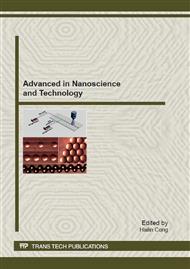[1]
F. Šebesta, J. John and A. Motl, K. Rosííková., Study of combined processes for the treatment of liquid radioactive waste containing complexing agents Combined methods for liquid radioactive waste treatment, IAEA, VIENNA, 2003, p.74.
Google Scholar
[2]
Frost C. R., The fixation of Cesium on Australian Minerals. Part 1. Vermiculite Minerals. Atom Energy of Australia, 15(1963)14.
Google Scholar
[3]
Manu V., Haresh M. Mody, Hari C. Bajaj, Raksh V. Jasra. Adsorption of Cu2+ on Amino Functionalized Silica Gel with Different Loading, Ind. Eng. Chem. Res., 48 (2009) 8954-8960.
DOI: 10.1021/ie900273v
Google Scholar
[4]
Veli S. Alyuz, B., Kinetics and equilibrium studies for removal of nickel and zinc from aqueous solutions by using natural clay, J. Hazard. Mater. 149 (2007) 226-233.
Google Scholar
[5]
Tahir, S. S., Naseem, R. Removel of Cr (III) from tannery wastewater by adsorption onto bentonite clay. Sep. Purif. Technol. 53(2007)312.
DOI: 10.1016/j.seppur.2006.08.008
Google Scholar
[6]
Aguado, J., Arsuaga, J. M., Arencibia, A., Lindo, M., et. al., Adsorption of heavy metals from aqueous solution by amine-functionalized mesoporous silica gel, J. Hazard. Mater., 163 (2009) 213-221.
DOI: 10.1016/j.jhazmat.2008.06.080
Google Scholar
[7]
Prado A. G. S., Arakaki L. N. H., Airoldi C. Adsorption and separation of cations on chemically modified silica gel synthesized via the sol-gel process, J. Chem. Soc., Dalton Trans. 14(2001)2206l.
DOI: 10.1039/b102478g
Google Scholar
[8]
Prado A. G. S., Arakaki L. N. H., Airoldi C. Adsorption and separation of cations on silica gel chemically modified by homogeneous and heterogeneous routes with the ethylenimine anchored on thiol modified silica gel, Green Chem. 4(2002)42.
DOI: 10.1039/b108749e
Google Scholar
[9]
A. S. Maria Chong and X. S. Zhao. Functionalization of SBA-15 with APTES and Characterization of Functionalized Materials, J. Phys. Chem. B 107(2003) 12650-12657.
DOI: 10.1021/jp035877+
Google Scholar
[10]
Toshiyuki Yokoi, a Hideaki Yoshitakeb, Takashi Tatsumi, Synthesis of amino-functionalized MCM-41 via direct co-condensation and post-synthesis grafting methods using mono-, di- and tri-amino-organoalkoxysilanes, J. Mater. Chem., 14 (2004).
DOI: 10.1039/b310576h
Google Scholar
[11]
A. Benhamoua, M. Baudub, Z. Derrichea, et. al. Aqueous heavy metals removal on amine-functionalized Si-MCM-41 and Si-MCM-48, Journal of Hazardous Materials, 171(2009)1001-1008.
DOI: 10.1016/j.jhazmat.2009.06.106
Google Scholar
[12]
M.S. Sadjadi, N. Farhadyar, K. Zare, Synthesis of nanosize MCM-41loaded with TiO2 and study of its photocatalytic activity, Superlattices and Microstructures 46(2009)266-271.
DOI: 10.1016/j.spmi.2008.12.024
Google Scholar
[13]
Zeid Abdullah Al-othman. Synthesis, modification and application of mesoporous materials based on MCM-41, PhD of Oklahoma State University, 2006, 204.
Google Scholar
[14]
I.M. El-Nahhal, R.V. Parish, Insoluble ligands and their applications. III. Polysiloxane diaminoethane derivatives, J. Organomet. Chem. 1993, 452: 19–22.
Google Scholar


